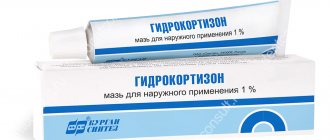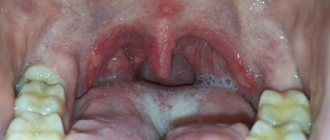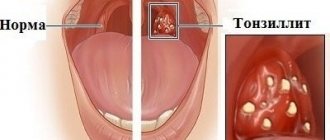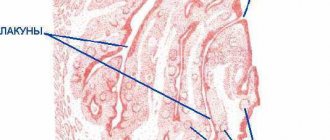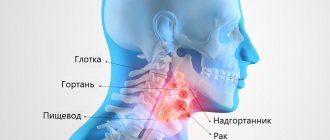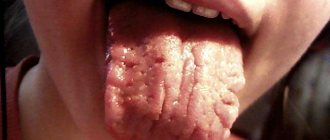The powerful lymph nodes located around the pharynx cannot cope with the attack of the pathogen, so the body begins to produce antibodies that can find pathogenic bacteria, paralyzing their activity.
As a result, streptococci are defeated, but the child’s body produces so many antibodies that, in addition to foreign cells, the body’s own tissues, primarily the heart and joints, begin to suffer. Therefore, it is always better to entrust the treatment of sore throat in a child to a qualified doctor.
In 10% of cases, sore throat in children can be caused by Staphylococcus aureus, rarely pneumococcus, Haemophilus influenzae, chlamydia and fungal flora. Viral pathogens (adenoviruses, herpes virus) more often attack the body of children under 3 years of age.
How and why does infection occur?
Infection occurs by airborne droplets, from a sick person, by using shared utensils and eating contaminated food, as well as by a number of other factors:
- weakened immunity;
- hypothermia or consumption of cold foods and drinks;
- mouth breathing (for chronic adenoiditis, deviated nasal septum);
- irritation of the nasopharyngeal mucosa with a runny nose;
- recent viral diseases;
- inflammatory diseases of the ENT organs (sinusitis, sinusitis, otitis);
- caries and other oral infections.
Secondary tonsillitis in children can occur against the background of scarlet fever, diphtheria, mononucleosis, as well as blood diseases.
In any case, a sore throat develops rapidly, in a matter of hours, and is especially acute in children, accompanied by the main symptoms—a sore throat when swallowing and an increase in body temperature.
Possible complications
As a rule, the viral form of tonsillitis, if a sore throat is treated correctly and in a timely manner, does not pose a danger and goes away without complications.
ARVI can be complicated by the addition of a bacterial infection of the nasal cavity: a characteristic sign is green discharge from the nose. The prognosis for this development is favorable, just the duration of treatment will increase by several days.
Influenza viruses cause complications more often than other viruses. This can be pneumonia, lung abscess, hepatitis, diseases of the heart muscle, neuritis. Adenoviruses can cause sinusitis and pneumonia.
A common consequence of viral tonsillitis is infection of the oral cavity and pharynx by fungus. Bacterial tonsillitis often develops. Exacerbations of chronic diseases are possible.
Sore throat in children: forms and clinical manifestations
Depending on the nature of the change and the degree of damage to the tonsils, several forms of angina are distinguished.
Catarrhal sore throat
A mild form, characterized by enlargement and redness of the tonsils, as well as the absence of purulent lesions. The child feels dry mouth, a whitish coating appears on the tongue, and the cervical lymph nodes are slightly enlarged. In addition to a sore throat that gets worse when swallowing, the child feels a sore and burning sensation. The temperature rises to 38 degrees, children complain of weakness and headache.
Follicular tonsillitis
A serious disease in which the tonsils become covered with purulent pinpoint follicles. On days 2-3, the ulcers open, leaving wounds that heal quickly. There is severe pain in the throat, radiating to the ear, making it difficult to swallow, children refuse to eat and drink. The lymph nodes are enlarged and painful when pressed lightly. Fever and chills are accompanied by a temperature of up to 40 degrees, vomiting, convulsions and fainting are possible.
Lacunar tonsillitis
In the lacunae, between the lobes of the tonsils, islands of yellow purulent plaque appear, which tend to unite into wide purulent foci. The symptoms are similar to those of purulent follicular tonsillitis, but are more pronounced and are accompanied by severe intoxication of the body. It hurts the child to turn his head, his mouth opens with difficulty, which makes speech slurred.
Viral (herpetic) sore throat
Most often, the development of the disease is facilitated by vitamin deficiency and weakened immunity. The tonsils become covered with red blisters, which burst, leaving small ulcers in their place. In addition to a sore throat, symptoms are acute respiratory in nature: cough, runny nose, abdominal pain, indigestion, as well as stomatitis and conjunctivitis. Lack of timely treatment of herpetic sore throat in children can lead to serous meningitis.
Fungal tonsillitis
A relatively mild form of sore throat that occurs in children under 3 years of age. It is distinguished by a coating of white, curdled flakes on the tonsils and, with proper treatment, goes away within a week.
Acute tonsillitis (common name - sore throat)
an infectious disease with local manifestations in the form of acute inflammation of the components of the lymphatic pharyngeal ring, most often the palatine tonsils, caused by streptococci or staphylococci, less often by other microorganisms, viruses and fungi. Sore throat is also called exacerbation of chronic tonsillitis.
The most common are vulgar (ordinary, banal) tonsillitis: catarrhal, lacunar, follicular, fibrinous, phlegmonous, herpetic and ulcerative membranous. In recent years, all types of tonsillitis have been called acute tonsillitis.
Catarrhal
Catarrhal tonsillitis develops acutely, the patient complains of a burning sensation in the throat, dryness, soreness, and then there is slight pain when swallowing. A clinical picture of astheno-vegetative syndrome is observed. The temperature is usually low-grade. Upon examination, the tonsils are hyperemic, somewhat enlarged in size, and in some places may be covered with a thin film of mucopurulent exudate. The tongue is dry and coated. There is a slight increase in regional lymph nodes. Typically, clinical manifestations disappear within 3-5 days.
Follicular
Follicular tonsillitis begins with an increase in body temperature to 38-39 °C. And the occurrence of severe pain in the throat when swallowing, often radiating to the ear. Depending on the severity of intoxication, headache, lower back pain, fever, chills, and general weakness occur. Most often, the submandibular lymph nodes are enlarged and their palpation is painful. There is hyperemia of the soft palate and tonsils, on the surface of which numerous round, somewhat raised yellowish or yellowish-white dots are visible. The duration of the disease is 5-7 days.
Lacunarnaya
Lacunar tonsillitis occurs with symptoms similar to follicular tonsillitis, but more severe. With it, yellowish-white plaques appear against the background of the hyperemic surface of the enlarged tonsils. The duration of the disease is 5-7 days.
Fibrinous
Fibrinous tonsillitis is characterized by the formation of a single continuous plaque of a whitish-yellow color, which can extend beyond the tonsils. This type of sore throat can develop from lacunar or proceed independently with the presence of a continuous film already in the first hours of the disease. In the latter case, an acute onset is characteristic with high fever, chills, severe symptoms of general intoxication, sometimes with signs of brain damage.
Phlegmonous (intratonsillar abscess)
Phlegmonous tonsillitis is relatively rare. Its development is associated with purulent melting of the tonsil area. The defeat is usually unilateral. The tonsil is enlarged, hyperemic, its surface is tense, and painful on palpation. On examination, a forced position of the head and enlarged regional lymph nodes, painful on palpation, are characteristic. Complaints of sore throat when swallowing, talking; headache, increased body temperature to 39-40 °C, symptoms of general intoxication. Pharyngoscopy: the tonsil is enlarged, hyperemic, its surface is tense, and painful on palpation. Characterized by trismus of the masticatory muscles, asymmetrical pharynx due to displacement of the uvula and tonsil to the healthy side. The mobility of the soft palate is limited.
Herpetic
Herpetic sore throat often develops in childhood. Its causative agent is the Coxsackie A virus. The disease is highly contagious and is transmitted by airborne droplets and rarely by the fecal-oral route. Herpetic sore throat debuts acutely, fever appears, the temperature rises to 38-40 ° C, sore throat occurs when swallowing, headache, muscle pain in the abdomen; There may be vomiting and diarrhea. Small reddish bubbles are visible in the area of the soft palate, uvula, palatine arches, tonsils and posterior wall of the pharynx. After 3-4 days, the blisters burst or resolve, and the mucous membrane takes on a normal appearance.
Ulcerative-membranous
The causative agent of ulcerative membranous sore throat is considered to be a symbiosis of a spindle-shaped bacillus and an oral spirochete, which often live in the oral cavity of healthy people. Morphological changes are characterized by necrosis of the surface of one tonsil with the formation of an ulcer. The patient complains of a feeling of awkwardness and a foreign body when swallowing, putrid odor from the mouth, and increased salivation. Body temperature, as a rule, is not elevated. There is moderate leukocytosis in the blood. Regional lymph nodes are enlarged on the affected side. The duration of the disease is from 1 to 3 weeks, sometimes lasting several months.
In more than 50%[1] cases of angina, the main etiological role belongs to group A β-hemolytic streptococcus, adenoviruses, herpes virus, Coxsackie Enterovirus, Vincent's spirochete, and Candida fungi.
Predisposing factors: local and general hypothermia of the body, decreased local and general immunity, trauma to the tonsils, the state of the central and autonomic nervous system, impaired nasal breathing, chronic inflammatory processes in the oral cavity, nose and paranasal sinuses[1].
Clinical manifestations
In acute primary tonsillitis, the clinical picture is manifested by symptoms of damage to the tonsils - varying degrees of pain in the throat when swallowing, signs of general intoxication, hyperemia, swelling of the tonsils, fibrinous-purulent plaque at the mouths of the lacunae, grayish-yellow plaque, under which superficial low-painful ulcers are found, regional lymphadenitis.
A sore throat begins with a sore throat and a sharp increase in body temperature to 39–40 °C (sometimes up to 41 °C). Sore throat is usually severe and sharp, but can also be mild. Lymph nodes enlarge. They can be easily felt under the lower jaw and cause pain. Sore throat can also occur at lower body temperatures - from 37 to 38 ° C, but with greater damage to the throat.
Sore throat often occurs with ARVI, especially of adenoviral origin, but enlarged lymph nodes are relatively rare.
Diagnostics
The main diagnostic technique for recognition is examination of the pharynx - pharyngoscopy, as well as assessment of complaints and medical history. Also, to determine the type of infection, a smear of mucus or pus is taken from the tonsils. The biomaterial is sent for various types of tests according to the decision of the attending physician.
Complications
The most common complications of tonsillitis are acute otitis media, acute laryngitis, laryngeal edema, neck phlegmon, peripharyngeal abscess, and acute cervical lymphadenitis.
Treatment
Basic recommendations: bed rest in the first days of the disease, a non-irritating, soft and nutritious diet, vitamins, and drinking plenty of fluids.
In the treatment of sore throat, the choice of drug depends on the type of microbe that caused the disease. The type of drug, dosage and method of administration are determined by the attending physician.
- In the treatment of bacterial sore throats, various types of antibiotics and antimicrobial drugs of synthetic origin are used (depending on the sensitivity of the microbe and the patient’s response to medications), various local antiseptics, which are available in the form of a spray or aerosol, as well as tablets, lozenges and lozenges.
- In the treatment of fungal tonsillitis (this disease is provoked mainly by a fungus from the genus Candida), antifungal drugs are used. Fungal tonsillitis often occurs after long-term treatment with antibiotics.
- Treatment of viral tonsillitis involves the use of anti-inflammatory drugs, as well as symptomatic drugs.
Often, for sore throat of any origin, the otolaryngologist prescribes various antiseptic and cleansing solutions for gargling, which are prescribed for use hourly. Recently, experts believe that gargling does not speed up the healing process, but may make you feel better.
At temperatures above 38 degrees, you can take antipyretics. For bacterial etiology of sore throats, in many cases an antibiotic is prescribed that is active against coccal flora (streptococci and staphylococci), the course is carried out for at least 7 days,
Prevention
To prevent tonsillitis, timely sanitation of foci of chronic infection (carious teeth, chronic tonsillitis, purulent lesions of the paranasal sinuses, etc.) and elimination of the causes of impaired nasal breathing are necessary.
Sore throat can be contagious (especially with scarlet fever), so the patient should be placed in a separate room, often ventilated and wet cleaned, and children and the elderly should not be allowed near him. A special container is provided for the patient, which is boiled or doused with boiling water after each use.
Gargling solutions:
- Furacilin solution (ready-made pharmaceutical solution does not need to be diluted)
- Chlorhexidine solution (for adults – without dilution, for children, one part of chlorhexidine is 2 parts of water)
- Chlorophyllipt alcohol solution (one teaspoon per 100 ml of water)
- Pharmaceutical propolis tincture (5-10 drops per 100 ml of water)
- Herbal decoctions (chamomile, calendula, sage in a mixture or separately)
To ensure that rinsing is effective:
- The solution must be warm
- One rinsing episode should be at least 30 seconds in duration.
- After rinsing, it is advisable to refrain from drinking or eating for an hour.
It is necessary to gargle with a course (at least 3 times a day for 5 days)
- Fennel fruits -10.0
- Mint leaves – 30.0
- Chamomile flowers – 30.0
- Sage leaves - 30.0
Use 1/2 cup as a warm infusion to rinse for laryngitis, tonsillitis, and sore throats.
Infectious disease doctor Milena Krinitsina
UZ "22 - Yagorodskaya Polyclinic"
Why is a sore throat dangerous?
As practice shows, only in half of the cases are enlarged tonsils and sore throat caused by purulent sore throat. Many diseases, such as diphtheria or Epstein-Barr virus, have symptoms similar to sore throat. Therefore, only a qualified doctor with modern diagnostic equipment and a well-equipped laboratory can accurately determine the disease and prescribe the necessary treatment.
Each causative agent of sore throat is sensitive to a certain type of antibiotics prescribed by a doctor depending on the diagnosis.
Remember!
Incorrect or untimely treatment of sore throat in children, as well as relying on folk remedies for “red throat” can lead to serious complications and irreversible consequences.
Delay in diagnosis and prolonged treatment provoke the development of rheumatoid arthritis, vascular diseases, heart diseases (including rheumatic endocarditis), renal failure and many chronic diseases leading to disability.
Why do you need to undergo streptotest?
Sore throat is very contagious. The severity of the disease depends on how long the contact with the sick person was and how many viruses the person received from him. And here the principle is the same as with any infectious disease, including coronavirus. The lower the dosage, the better. It is clear that the mask does not completely save, but nevertheless reduces the amount of virus or microbe that has entered the body. This means that a person will get sick more easily.
If you have a sore throat, it is fundamentally important to understand what caused the disease - a virus or a microbe. The choice of drugs depends on this - antiviral or antibiotics. This certainly cannot be done without special tests. One can only guess. For example, with the mildest, viral form of tonsillitis (catarrhal), when the mucous membrane that covers the tonsils (tonsils) and the back wall of the pharynx becomes inflamed, the throat usually just turns red, hurts and feels sore.
Many faces of sore throat. The doctor talks about 7 types of disease and the difference in treatment Read more
But if white plaques appear on the tonsils, most likely, bacterial tonsillitis. Usually in this case there is a very severe sore throat, high temperature, severe intoxication (nausea, muscle aches). Before buying antibiotics, it is better to purchase a streptotest at the pharmacy and carry out a diagnosis. A swab is taken from the throat and the color of the strip determines whether it is streptococcal sore throat, the most severe, or viral inflammation. But it is better to do this together with your doctor in order to choose the right treatment.
Forms of the disease in children
All types of acute tonsillitis occur in children, but their prevalence depends on age.
Sore throat in a child 1-3 years of age is more likely (44% of cases) associated with a herpetic infection2. Only 35% of cases of the disease are the result of the activity of streptococci2.
In children aged 3 to 7 years, tonsillitis is more often bacterial, but streptococci are found only in 28% of cases2. Further, the picture changes towards the predominance of streptococcal infection and in adolescents it already accounts for up to 52% of cases of inflammation.
According to the picture of pathological changes in the tonsils1, inflammation of the tonsils can be:
- Erythematous (catarrhal), accompanied by redness of the tonsils and palatine arches. Viral tonsillitis, streptococcal (in the initial stages of development) or atypical, caused by Yersinia, mycoplasma, chlamydia, have such a clinical picture.
- Vesicular, characterized by the appearance of vesicles with turbid liquid on the tonsils, after opening of which small erosions form on the mucous membrane. This is how herpetic sore throats, tonsillitis with measles, and chickenpox occur.
- Membranous, in which purulent or necrotic films appear on the tonsils1. In lacunar forms, the film forms pus flowing from the lacunae, which is easily removed with a swab2. True films in diphtheria are firmly connected to the underlying tissue of the tonsils2.
According to the severity of the course, acute tonsillitis in children can be:
- light,
- moderate severity,
- heavy.
With the flow:
- without complications,
- with complications.
Up to contents
Signs of tonsillitis
The most reliable local signs of chronic tonsillitis are:
- Hyperemia and roller-like thickening of the edges of the palatine arches.
- Cicatricial adhesions between the tonsils and palatine arches.
- Loose or scarred and hardened tonsils.
- Caseous-purulent plugs or liquid pus in the lacunae of the tonsils.
- Regional lymphadenitis is an enlargement of the cervical lymph nodes.
The diagnosis is made in the presence of two or more of the above local signs of tonsillitis. In the compensated form, there are only local signs of chronic inflammation of the tonsils, the barrier function of which and the reactivity of the body are still such that they balance and even out the state of local inflammation, i.e. compensate for it, so a pronounced general reaction of the body does not occur.
In case of decompensation, there are not only local signs of chronic inflammation, but also tonsillitis, paratonsillitis, paratonsillar abscesses, diseases of distant organs and systems (cardiovascular, genitourinary, etc.)
Any form of chronic tonsillitis can cause allergization and infection of the entire body. Bacteria and viruses located in the lacunae under appropriate conditions (cooling, decreased body resistance, and other reasons) cause local exacerbations in the form of sore throats and even peritonsillar abscesses.
Rice. 1. Chronic follicular tonsillitis. Rice. 2. Chronic lacunar tonsillitis. Rice. 3. Chronic tonsillitis (Preobrazhensky sign). Rice. 4. Chronic tonsillitis (Gise’s sign)
